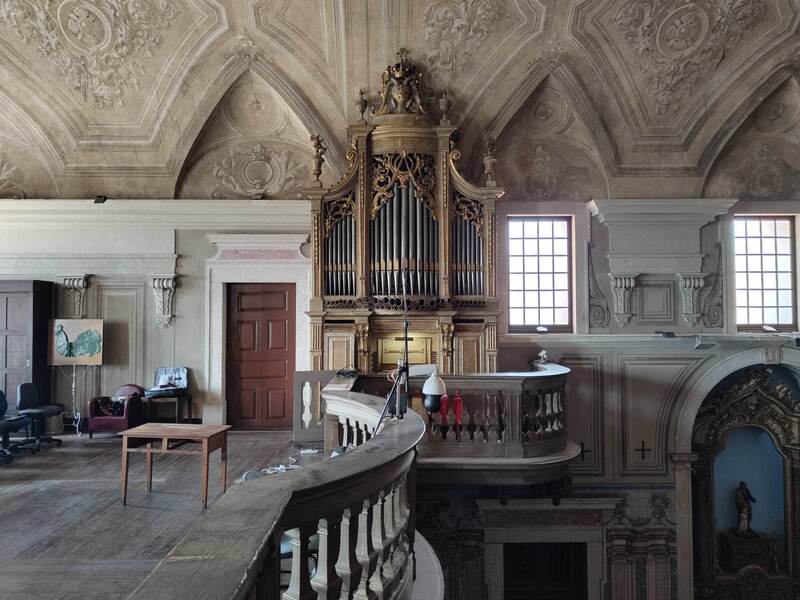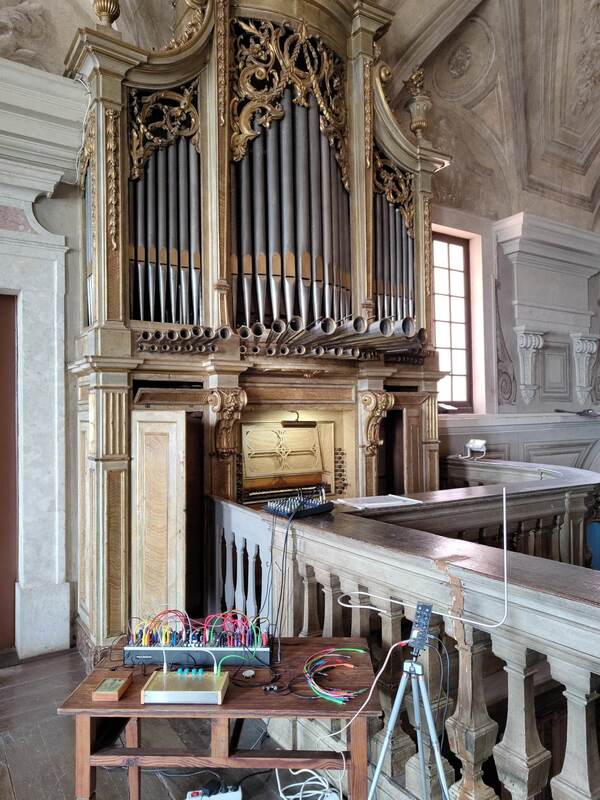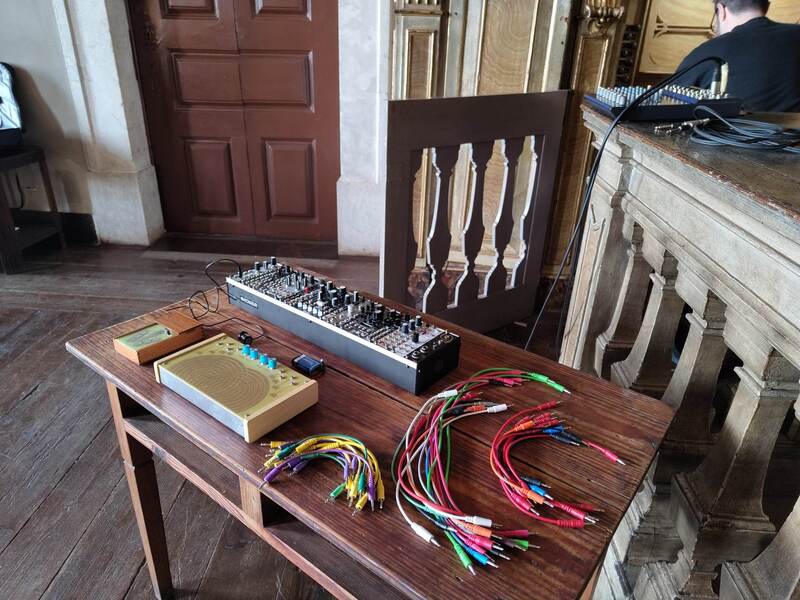Booklet
 Aether Ventus (2023)
Aether Ventus (2023)
Aether Ventus is an album that explores the intersection of historical and modern techniques in the field of music improvisation. The album features Cláudio de Pina on the Portuguese historical organ (in Parish of Our Lady of Ajuda, built by Ant.º X. M. Cerveira in 1792), using his own extended techniques developed specially for this instrument, intertwined with the electronic sounds and menagerie of Andrew Levine's unique modular synths and theremin.
Pina and Levine endeavour for a new element, which in their imagination constitutes a mix of wood, metal and wind, Ventus, with electricity and electromagnetism, Aether. The result is a blend between the ancient organ and modern electronics, creating a sonic journey that transports the listener to new realms. This journey is improved by the use of ambisonic recording, which creates a three-dimensional immersive sound field, allowing the listener to experience the full range of the organ and electronics sounds.
Pina and Levine endeavour for a new element, which in their imagination constitutes a mix of wood, metal and wind, Ventus, with electricity and electromagnetism, Aether. The result is a blend between the ancient organ and modern electronics, creating a sonic journey that transports the listener to new realms. This journey is improved by the use of ambisonic recording, which creates a three-dimensional immersive sound field, allowing the listener to experience the full range of the organ and electronics sounds.
In this album you will find elements of intuitive music, free improvisation and real time composition coupled with extended techniques on the Portuguese organ and a specially designed modular synthesizer controlled by theremin, stereo field and crackle box.
Aether Ventus it is also a celebration of the centenary of Hungarian composer György Ligeti and his avant-garde legacy. Inspired by Ligeti's use of clusters of notes, unconventional music notation, micropolyphony, microtonalism, electronic sounds and rhythms, this album explores the interconnection of contemporary classical music and electronic soundscapes.
Through the fusion of organ and electronics the album aims to create a unique sonic experience that pays homage to Ligeti's innovative spirit. A testament to Ligeti's enduring influence on contemporary music and his legacy as one of the most important avant-garde composers of the 20th century.
Aether Ventus it is also a celebration of the centenary of Hungarian composer György Ligeti and his avant-garde legacy. Inspired by Ligeti's use of clusters of notes, unconventional music notation, micropolyphony, microtonalism, electronic sounds and rhythms, this album explores the interconnection of contemporary classical music and electronic soundscapes.
Through the fusion of organ and electronics the album aims to create a unique sonic experience that pays homage to Ligeti's innovative spirit. A testament to Ligeti's enduring influence on contemporary music and his legacy as one of the most important avant-garde composers of the 20th century.
Lufftstrom Duo (Levine - Pina)
Cláudio de Pina uses advanced techniques to coax both familiar and expanded xenharmonic sounds from pipe organs like the Portuguese historical organ (1792) of Ajuda’s church.
Andrew Levine shapes sounds in the air with the Theremin and modular synthesizer, merging with and contrasting with the multiple organ’s sounds.
Both work together to weave a sonic tapestry that acts as a key to a universe of strange and magical images, similar to a surreal film…
Andrew Levine shapes sounds in the air with the Theremin and modular synthesizer, merging with and contrasting with the multiple organ’s sounds.
Both work together to weave a sonic tapestry that acts as a key to a universe of strange and magical images, similar to a surreal film…
Technical data
Recorded in the 2nd of May in the Church of Our Lady of Ajuda in Lisbon in Ambisonic format with Spcmic by Harpex Audio and a stereo feed from the electronics. Loudspeakers for the electronics were inclosed in the organ case.
Mixed mastered and converted to binaural and stereo by Andrew Levine.
Andrew Levine used a unique designed modular synthesizer controlled (via CV and envelope following, amognst many other means) with Open Theremin, Crackle Box, Stereo Field, Soma pipe mic and piezo mic.
Cláudio de Pina plays the Portuguese historical organ (in Parish of Our Lady of Ajuda, built by Ant.º X. M. Cerveira in 1792). He used fishing weights (150g and 50g), ohashi, pipes, metal rods, wood rods and air supply manipulation with the stops and motor.
Design and texts by Cláudio de Pina.
Watercolour painting for the cover by Francisco Cadete.
Production by Andrew Levine & Cláudio de Pina.
Distributed and edited by blumlein records.
Mixed mastered and converted to binaural and stereo by Andrew Levine.
Andrew Levine used a unique designed modular synthesizer controlled (via CV and envelope following, amognst many other means) with Open Theremin, Crackle Box, Stereo Field, Soma pipe mic and piezo mic.
Cláudio de Pina plays the Portuguese historical organ (in Parish of Our Lady of Ajuda, built by Ant.º X. M. Cerveira in 1792). He used fishing weights (150g and 50g), ohashi, pipes, metal rods, wood rods and air supply manipulation with the stops and motor.
Design and texts by Cláudio de Pina.
Watercolour painting for the cover by Francisco Cadete.
Production by Andrew Levine & Cláudio de Pina.
Distributed and edited by blumlein records.
Methodology
In the 1970s Ligeti presented at an organology conference, 'What does the composer of our time expect from the organ'. Aether Ventus is an applied study inspired by the nine objectives set out in that article. The methodology will use tools from music interpretation and analysis studies. The organ and the thermin are mutual exclusive regarding their sound morphology (Pina, 2023):
|
Organ
*possibility to alter these values with extended techniques applied to historical pipe organs. For more information regarding these techniques consult here. |
Theremin
*extreme possibility to alter these values with both pitch & volume output as continuous analog control voltages (CV) to control several aspects of a eurorack modular synthesizer. |
Eurorack Modular design
The idea of this configuration is that it allows me to loop in an external source, e.g. an electromagnetic pickup for the STEIM Cracklebox and feed a multiple waveshape VCO (After Later Audio Brooks) with the envelope. A multi output LFO (Joranalogue Audio Design Orbit 3) is used to control a VCA (Bubblesound HEXvca) to attenuate several of the Brooks' sounds while also being synced to the extracted envelope.
A second VCO (Befaco Pony VCO) is the voice of the OpenTheremin, the wavetable of which does not provide musically interesting results.
Since I played several solo concerts I wanted to be able to trigger and control pads / drone like components to my performance, which is where the granular module (Qu-Bit Electronix Nebulae v2) comes in. I generally slowed down the samples (selected from several recordings of mine) and manipulated their direction using the Stereo Field.
The Stereo Field was also used as a sound generator, but since the (purposefully) unstable circuits tend to exhibit a lot of HF content I passed them through a low pass VCF (Vult DSP Freak Manifold Filter) before mixing them with the other sources.
In some sets I added my voice (via Christian Günther (CG) Products Pre and processed with the Erica Synths Pico DSP). The original set list included the SOMA Pipe, but due to weight restrictions I took only the contact microphone, which Vlad Kreimer told me actually stood at the beginning of his design process.
To keep my kit compact I didn't bring an external mixer but used two Eurorack modules (Bastl Instruments Buddy & Intellijel Designs Mixup) to mix and level the sources and subsequently record them "in box" (4ms Company WAV Recorder). A passive, transformer coupled DI (Meng Qi Please Exist 2) was very useful in several occasions to avoid ground hum issues. (Levine, 2023)
The idea of this configuration is that it allows me to loop in an external source, e.g. an electromagnetic pickup for the STEIM Cracklebox and feed a multiple waveshape VCO (After Later Audio Brooks) with the envelope. A multi output LFO (Joranalogue Audio Design Orbit 3) is used to control a VCA (Bubblesound HEXvca) to attenuate several of the Brooks' sounds while also being synced to the extracted envelope.
A second VCO (Befaco Pony VCO) is the voice of the OpenTheremin, the wavetable of which does not provide musically interesting results.
Since I played several solo concerts I wanted to be able to trigger and control pads / drone like components to my performance, which is where the granular module (Qu-Bit Electronix Nebulae v2) comes in. I generally slowed down the samples (selected from several recordings of mine) and manipulated their direction using the Stereo Field.
The Stereo Field was also used as a sound generator, but since the (purposefully) unstable circuits tend to exhibit a lot of HF content I passed them through a low pass VCF (Vult DSP Freak Manifold Filter) before mixing them with the other sources.
In some sets I added my voice (via Christian Günther (CG) Products Pre and processed with the Erica Synths Pico DSP). The original set list included the SOMA Pipe, but due to weight restrictions I took only the contact microphone, which Vlad Kreimer told me actually stood at the beginning of his design process.
To keep my kit compact I didn't bring an external mixer but used two Eurorack modules (Bastl Instruments Buddy & Intellijel Designs Mixup) to mix and level the sources and subsequently record them "in box" (4ms Company WAV Recorder). A passive, transformer coupled DI (Meng Qi Please Exist 2) was very useful in several occasions to avoid ground hum issues. (Levine, 2023)
Recording techniques
The main microphone used to capture the organ and the acoustics of the space was the Spcmic by Harpex Audio. Each of the two flat sides contains 42 MEMS-capsules embedded in fibre glass. The resultant 84-channel stream can be auditioned in realtime and rendered to a multitude of output formats, such as various flavors of stereo, 1st, 2nd and 3d order Ambisonics, binaural, Atmos and Hamasaki 22.2 (Levine, 2023).
The loudspeakers enclosed in the organ cabinet provide the natural reverberation of the church, besides filtering and creating a natural resonance to the electronic part (no need to apply reverb in post-production). In this way the sounds of the organ and electronics are naturally mixed, according to Ligeti’s idea about electronic music and loudspeakers (Pina, 2023).
The main microphone used to capture the organ and the acoustics of the space was the Spcmic by Harpex Audio. Each of the two flat sides contains 42 MEMS-capsules embedded in fibre glass. The resultant 84-channel stream can be auditioned in realtime and rendered to a multitude of output formats, such as various flavors of stereo, 1st, 2nd and 3d order Ambisonics, binaural, Atmos and Hamasaki 22.2 (Levine, 2023).
The loudspeakers enclosed in the organ cabinet provide the natural reverberation of the church, besides filtering and creating a natural resonance to the electronic part (no need to apply reverb in post-production). In this way the sounds of the organ and electronics are naturally mixed, according to Ligeti’s idea about electronic music and loudspeakers (Pina, 2023).
Acknowledgements
Andrew Levine & blumlein records, for the mixing and editing
Harpex Audio, for the Spcmic
GIMC (CESEM) & FCT, for the support
Francisco Cadete, for the artwork
Paróquia da Nossa Senhora da Ajuda, for permission to record this albumGyörgy Ligeti, for the inspiration
Harpex Audio, for the Spcmic
GIMC (CESEM) & FCT, for the support
Francisco Cadete, for the artwork
Paróquia da Nossa Senhora da Ajuda, for permission to record this albumGyörgy Ligeti, for the inspiration
Radio air time

Aether Ventus featured in The Moderns by Kevin Press (23 Jul.)
themoderns.blog/2023/07/23/the-moderns-ep-272/
themoderns.blog/2023/07/23/the-moderns-ep-272/
Reviews and testimonials

Diana Ferreira in Ípsilon magazine, Público journal: "Music is made from the air: Cláudio de Pina explores an infinity of sonic possibilities with the historic organ of Ajuda." (4.5/5)
Avant-garde Organ is neither the first nor the last album by composer, sound artist and organist Cláudio de Pina, who in May released Aether Ventus (Blumlein Records) with Andrew Levine, in which he celebrates the avant-garde legacy and innovative spirit of György Ligeti (1923-2006), in a work inspired by his use of clusters -- a record that crosses the Iberian organ of the Parish of N.ª Sra. da Ajuda, in Lisbon, where Pina is titular organist, and which he performs with his own expanded techniques, with Levine's theremin and modular synthesisers.
Avant-garde Organ is neither the first nor the last album by composer, sound artist and organist Cláudio de Pina, who in May released Aether Ventus (Blumlein Records) with Andrew Levine, in which he celebrates the avant-garde legacy and innovative spirit of György Ligeti (1923-2006), in a work inspired by his use of clusters -- a record that crosses the Iberian organ of the Parish of N.ª Sra. da Ajuda, in Lisbon, where Pina is titular organist, and which he performs with his own expanded techniques, with Levine's theremin and modular synthesisers.

Sean Worral in the Organ review:
Cláudio de Pina and Andrew Levine get all Messiaen, Gustav Kwarts, Yann Tiersen on a boat with Quinquis, Meredith Bates and a plague of lighthouse keeper [...] now this feels rather Messiaen, this is meant as a compliment, or maybe the out there Guy Evans bits on Van Der Graaf’s Plague of Lightojuse Keepers, an event bigger compliment – "Aether Ventus is an album that explores the intersection of historical and modern musical techniques. The album features Cláudio de Pina on the Portuguese historical organ (1792) of Ajuda’s church, using his own extended techniques developed specially for this instrument, intertwined with the electronic sounds and menagerie of Andrew Levine’s unique modular synths and theremin."
Cláudio de Pina and Andrew Levine get all Messiaen, Gustav Kwarts, Yann Tiersen on a boat with Quinquis, Meredith Bates and a plague of lighthouse keeper [...] now this feels rather Messiaen, this is meant as a compliment, or maybe the out there Guy Evans bits on Van Der Graaf’s Plague of Lightojuse Keepers, an event bigger compliment – "Aether Ventus is an album that explores the intersection of historical and modern musical techniques. The album features Cláudio de Pina on the Portuguese historical organ (1792) of Ajuda’s church, using his own extended techniques developed specially for this instrument, intertwined with the electronic sounds and menagerie of Andrew Levine’s unique modular synths and theremin."
Anna Shvets: "Thank you very much for sharing your new album - my congratulations for releasing it! I only started listening to ir, but I see already an incredible work you've done!"
Cláudio Oliveira: "Daqui e agora seguem os parabéns pelo lançamento desta obra, que entretanto após a escuta nos deixa a aguardar pela próxima celebração ao vivo."
Zsigmond Szathmáry: "Congratulations!!! Fantastic new sounds! Many thanks for this!" ""I've been recording contemporary organ music since the 1960s and still, when I listened to your album 'Aether Ventus' I discovered new sounds and possibilities. It's extraordinary!" [Conversation with Andrew Levine, 11/25, 2023]
Cláudio Oliveira: "Daqui e agora seguem os parabéns pelo lançamento desta obra, que entretanto após a escuta nos deixa a aguardar pela próxima celebração ao vivo."
Zsigmond Szathmáry: "Congratulations!!! Fantastic new sounds! Many thanks for this!" ""I've been recording contemporary organ music since the 1960s and still, when I listened to your album 'Aether Ventus' I discovered new sounds and possibilities. It's extraordinary!" [Conversation with Andrew Levine, 11/25, 2023]








